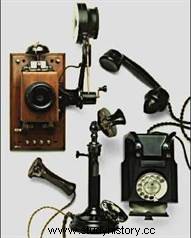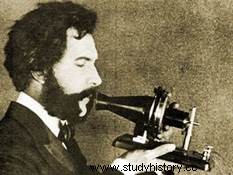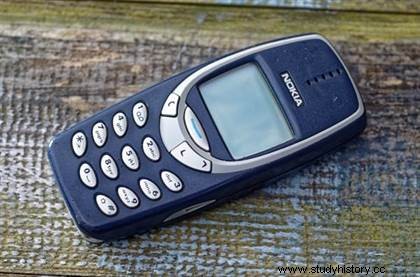 February 14, 1876, the American Graham Bell files the patent for the telephone invention . Considered an improvement on the telegraph that had become talking, this invention marked the beginning of a new era, that of globalization. Distances are abolished, and time becomes universal. The principle of the telephone was described in 1854 in France by Charles Bourseul , employee of the administration of the Telegraphs, who published in the newspaper "l'Illustration" an article describing a device to converse at a distance. At the time, he was not taken seriously...
February 14, 1876, the American Graham Bell files the patent for the telephone invention . Considered an improvement on the telegraph that had become talking, this invention marked the beginning of a new era, that of globalization. Distances are abolished, and time becomes universal. The principle of the telephone was described in 1854 in France by Charles Bourseul , employee of the administration of the Telegraphs, who published in the newspaper "l'Illustration" an article describing a device to converse at a distance. At the time, he was not taken seriously...
Graham Bell, inventor of the telephone
Alexander Graham Bell, a young Scotsman who emigrated to the United States, was interested in acoustics and taught speech to the mute in Boston. It is by considering the limits of the electric telegraph that he envisages a device capable of reconstituting a normal mode of communication using speech and hearing. Familiar with electromagnetic techniques, he is also interested in devices that use sound waves. This is how he tries to reproduce the internal structure of the ear, successfully, by transforming an acoustic wave into electric current through a vibrating metal blade
 Alexander Graham Bell filed the patent for his telephone system in March 1876, three hours before his compatriot Elisha Gray patented an equivalent device capable of transmitting voice. For more than ten years, a legal battle opposed Bell and Gray in the courts, which finally gave reason to this first. The telephone experienced an immediate boom and soon saw itself equipped with a microphone, invented by the American of British origin David Hughes in 1881.
Alexander Graham Bell filed the patent for his telephone system in March 1876, three hours before his compatriot Elisha Gray patented an equivalent device capable of transmitting voice. For more than ten years, a legal battle opposed Bell and Gray in the courts, which finally gave reason to this first. The telephone experienced an immediate boom and soon saw itself equipped with a microphone, invented by the American of British origin David Hughes in 1881.
Bell will also be at the origin of the American Telephone &Telegraph (A.T.T), the largest private company of the 20th century, sitting on a virtual monopoly in the United States . This power has worked a lot for the myth of this invention. Fair return:it is precisely on his status as the inventor of the telephone, and not of a telephone among others, that the fortune of this company was built.
What is the principle of the telephone?
When you speak into the microphone designed by Bell, a membrane vibrates:this causes the oscillation of a magnet and therefore the modification of its magnetic field. The magnet produces an electric current in the nearby coil of conductive wire; the characteristics of this electric current are similar to those of the sound produced. At the other end of the line, a similar (but inverse) device, the loudspeaker, reproduces the sound wave.
Early communications have a fairly short range, with the voice rapidly fading as the signal travels along the wire. Relays, expensive and moderately efficient, are first installed. They were replaced in 1906 by the first amplifiers (the triode of the American Lee de Forest):the extension of the network no longer seemed to have any limits.
The telephone, a player in globalization
From the 1910s, technological development accelerated considerably with the appearance of electronics; telephony became the first activity to commercially use the new possibilities offered by vacuum tubes. During the First World War, the various armies were thus equipped with radio equipment using electronic components. In 1926, shortwave links opened up a new type of commercial service:intercontinental telephone links. For the first time, it became possible to telephone between Paris and New York. It was at the same time that the first submarine telephone cables were installed, such as between France and England in 1927.
 Today, the telephone network continues to expand. Where the cable network is insufficient (between continents or in the most isolated places), the telephone can also use telecommunications satellites, or even certain radio waves. The first telephone connections through the Internet network were born in the early 2000s. On these telephone networks known as IP networks (Internet Protocol, networks using the Internet protocol; we also speak of IP telephony or VoIP for Voice over IP), the voice is digitized, compressed and then cut into packets that travel over the Internet before reaching the recipient's landline or mobile phone.
Today, the telephone network continues to expand. Where the cable network is insufficient (between continents or in the most isolated places), the telephone can also use telecommunications satellites, or even certain radio waves. The first telephone connections through the Internet network were born in the early 2000s. On these telephone networks known as IP networks (Internet Protocol, networks using the Internet protocol; we also speak of IP telephony or VoIP for Voice over IP), the voice is digitized, compressed and then cut into packets that travel over the Internet before reaching the recipient's landline or mobile phone.
Mobility and invention of the smartphone
Parallel to the development of the services offered by the landline telephone, the beginning of the 21st century saw the advent of mobile telephony. A mobile phone is a device where the connection wires to the telephone exchange have been replaced by a radio link. This kind of phone is theoretically usable anywhere:by car, train, on foot, etc. Radio stations connected to the conventional network are deployed for this purpose throughout the territory, each covering a small geographical area called a cell.
Because of this, cell phones do not need high power, which makes it possible to miniaturize them in the form of a handset with an antenna and integrating all the necessary devices. Each signal is transmitted on a carrier frequency corresponding to the cell in which the user is located at that time. Narrowband frequency modulation is the most common mode of transmission.
 The ancestor of the mobile phone is most certainly the heavy and cumbersome car phone that equips high-end vehicles. range of the 1960s. The year 1992 was a turning point in this area with the adoption in France and around the world of the GSM standard. (Global System for Mobile Communications) using a digital signal. The mobile phone became more democratic at the end of the 1990s to become an essential device in the majority of homes. In 2008, there were more than three billion users, for a use essentially consisting of voice communications and messages (SMS).
The ancestor of the mobile phone is most certainly the heavy and cumbersome car phone that equips high-end vehicles. range of the 1960s. The year 1992 was a turning point in this area with the adoption in France and around the world of the GSM standard. (Global System for Mobile Communications) using a digital signal. The mobile phone became more democratic at the end of the 1990s to become an essential device in the majority of homes. In 2008, there were more than three billion users, for a use essentially consisting of voice communications and messages (SMS).
The smartphone, a mobile phone with a touch screen, has since enjoyed dazzling success. Always more efficient and equipped with many features, it is a real small computer that allows multiple uses, from internet browsing to photography, including GPS guidance and games.
To go further
- Alexander Graham Bell, Inventor of the Telephone, by Michael Webb. Editions de la Chenelière, 1993.
- And Bell invented the telephone, by Orlando John Stevenson. Editions France-Empire, 1964.
- The fabulous history of inventions - From mastery of fire to immortality. Dunod, 2018.
- History of telecommunications in France, by Catherine Bertho. Eres, 1984.
